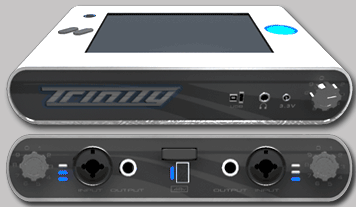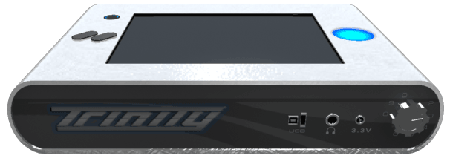Device Profile: Trinity Audio Group portable digital audio workstation
Jul 6, 2006 — by LinuxDevices Staff — from the LinuxDevices Archive — 8 views Start-up Trinity Audio Group (TAG) is using Linux and open source audio applications in a small, portable, inexpensive digital audio workstation (DAW) claimed capable of professional-quality recording and mixing. The Trinity DAW is based on an Intel PXA270 processor, and targets field recordists, podcasters, and producers. It will ship in October.
Start-up Trinity Audio Group (TAG) is using Linux and open source audio applications in a small, portable, inexpensive digital audio workstation (DAW) claimed capable of professional-quality recording and mixing. The Trinity DAW is based on an Intel PXA270 processor, and targets field recordists, podcasters, and producers. It will ship in October.

The Trinity DAW, front and back
TAG founder Ronald Stewart, a career record producer, says he designed the Trinity DAW in hopes of making music production more accessible, especially to young people. “What if you don't have $300,000 to make a song? We want to let you record and mix a masterpiece on the bullet train in Tokyo,” Stewart said.
Stewart adds, “We insist on pricing the DAW below $1,000, even though our BOM [bill-of-materials] cost is now $501, when it should be around $330.”
Stewart believes the Trinity DAW offers greater convenience and ease-of-use than laptops with external USB- or Firewire-based soundcards. And, it offers longer battery life, he says — about four hours under “rigorous audio demands.” Stewart said, “Our prototype was based on x86, but we switched to ARM for more battery life.”
 The Trinity DAW will let users record stereo 16- or 24-bit audio tracks at sample rates up to 96kHz (192kHz support is planned). It will also let users add effects to recorded or imported audio samples, and mix down multi-track audio through a graphical interface.
The Trinity DAW will let users record stereo 16- or 24-bit audio tracks at sample rates up to 96kHz (192kHz support is planned). It will also let users add effects to recorded or imported audio samples, and mix down multi-track audio through a graphical interface.
Additionally, the Trinity DAW will offer a wireless network interface, and run a normal web browser and other software enabling users to interact with two fledgling online music communities that TAG is starting. These include RainRadio, an Internet radio station, and National Beats Association (NBA) (logo pictured at right), an on-line drums and beat sharing library patterned after MySpace.com.
What's under the hood?
 |
(Click for details) |
The Trinity DAW will be based on a CompuLabs CM-X270L CPU processor module, along with a custom baseboard designed by TAG engineers. The CM-X270L module is based on an Intel XScale (soon to be Marvell) PXA270 processor clocked at 520MHz. The CompuLabs module also integrates an 802.11b WiFi interface, with 802.11g coming soon.
The Trinity DAW has 128MB of RAM, and boots from a 1.8-inch Hitachi hard drive with an initial capacity of 20GB. Its display is based on a 6.5-inch color LCD with VGA (640 x 480) resolution.
Additional I/O includes a USB host port, for the attachment of a USB hub or USB-based audio peripherals, and a USB device port, which can be used to attach the DAW to a PC, where its drive appears as a USB storage device.
The Trinity DAW measures 9.5 x 6 x 1.85 inches.
High-end audio subsystem
The Trinity DAW's audio system is licensed from Echo Audio, one of the best-known vendors of USB-, PCMCIA, and Firewire-based external sound cards for laptop-using recordists. “As a startup, no one knows who we are. We wanted to leapfrog that issue right off the bat by partnering with Echo,” Stewart said.
Echo may have a good reputation in the recording industry, but it is not known for products that support Linux. However, Echo's wm8731-based audio subsystem is supported through the Alsa project's ASoC layer, Stewart said.
Echo's wm8731-based audio subsystem will enable the first-generation Trinity DAW to support “pro quality” 24-bit recording at 96kHz sample rates, as well as 16-bit “cd-quality” and “DAT-quality” sample rates of 44.1kHz and 48kHz. Claimed signal-to-noise headroom ranges between 90db and 110db.
The Echo audio subsystem also includes a built-in headphone amplifier, allowing the Trinity DAW to include a 1/4-inch stereo microphone jack without adding $5 to the BOM cost, Stewart said.
For a future design, Trinity hopes to move to an Echo audio subsystem based on a higher-end AKM 4620 chipset. The AKM chipset supports sample rates up to 192kHz, along with ultra-quiet claimed signal-to-noise ratios up to 115db. “This chipset will offer sound quality way up the ladder,” Stewart said.
Both sound chips support a 2-in, 2-out format. The Trinity DAW uses clever “Neutrik” input jacks capable of accepting either balanced quarter-inch or XLR (microphone) plugs. Outputs are on balanced quarter-inch TRS (tip/ring/sleeve) jacks. Separate gain pots and clip LEDs are provided for each channel.
Front panel controls and I/O include gain pots, three-led clip meters, “Neutrik” jacks, 1/4-inch TRS outs, and “phantom power” button
Finally, a 48V “phantom power” circuit allows the Trinity DAW to be used with condensor microphones lacking their own power sources. Asked how phantom power use might affect battery life, Stewart admitted he had not been able to test the circuit yet. However, he said, “I'll stick to what I said about the four hours of battery life being under 'rigorous audio use.'”
Rear controls and I/O ports include USB host and device ports, and a quarter-inch stereo headphones jack with volume pot
Power a priority
The Trinity DAW is powered by a pair of SKC lithium-polymer-ion batteries, each delivering 4200 mAh. This enables real-world battery life of four hours, Stewart says, compared to about two hours for typical laptops. “The first engineer to work on this project invented the spin-down hard drive for Zenith and we built this product from the perspective of battery and power management first,” Stewart said.
Additionally, Stewart says a future revision of the Trinity DAW based on Intel's next-generation Monahans processor will offer even better battery life. “Monahans lets you switch off more parts of the processor when not in use. We want to eventually make a device that can be used for a full eight-hour workday between charges,” Stewart said.
Software side
The Trinity DAW's primary interface will be based initially on Audacity, a nicely polished open source multi-track editor available for a variety of operating systems, including Windows and Mac OS X. TAG hopes to use the latest 1.3 Audacity release, currently beta testing, which permits multiple clips-per-track, easy track resizing, and other advanced features. The Audacity team kindly ported its 1.3 release to ARM for Trinity's sake, Stewart notes.
TAG is also working on its own graphical frontend to Ecasound, a powerful commandline-based multi-track digital audio workstation software suite designed to work with the Jack low-latency audio server. The “Transmission” frontend also integrates with Hydrogen, an open source drum machine, and with VST-like LADSPA plug-ins.
Stewart concludes, “[Our DAW is] like ProTools, only better. It's portable, so you can take your work with you. The extended battery life, Linux OS, and on-board WiFi makes this a perfect all-in-one solution for recording and podcasting.”
Availability
TAG plans to ship its Trinity DAW in October, priced at $1,000.
This article was originally published on LinuxDevices.com and has been donated to the open source community by QuinStreet Inc. Please visit LinuxToday.com for up-to-date news and articles about Linux and open source.

